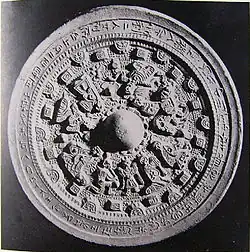Suda Hachiman Shrine Mirror
The Suda Hachiman Shrine Mirror (Japanese: 隅田八幡神社人物画像鏡, Hepburn: Suda Hachiman Jinja Jinbutsu Gazō-kyō) in Hashimoto, Wakayama, Japan is a National Treasure of Japan. It is a bronze mirror cast with 48 Chinese characters around the fifth century. It is an important artifact for the research in Japanese archaeology and Old Japanese language. It was found at Suda Hachiman Shrine.
| Suda Hachiman Shrine Mirror | |
|---|---|
| Native name Japanese: 隅田八幡神社人物画像鏡 | |
 Bronze mirror of Suda Hachiman Shrine | |
| Location | Hashimoto, Wakayama, Japan |
Inscriptions
The mirror says
癸未年八月日十大王年男弟王在意柴沙加宮時斯麻念長寿遣開中費直穢人今州利二人等取白上同二百旱作此竟
There are a few unclear points, but a tentative translation is "In the eighth month of a gui-wei year, in the reign of the great king, when the prince Wooto was at the Osisaka Palace, Sima, wishing for longevity, sent two persons to make this mirror from 200 han of brand-new and fine bronze." The year gui-wei likely corresponds to 443 or 503.
According to one prevailing opinion, the prince Wooto can be identified as the prince Oohodo, a grandson of Emperor Ōjin and a brother of Oshisaka-no-Oonakatsuhime (Emperor Ingyō's consort). Another theory holds that Wooto is Ōdo-no-Ookimi (Emperor Keitai). He may be a great-grandson (or a younger brother) of the prince Oohodo. If the gui-wei year corresponds to 503, Shima is presumed King Muryeong of Baekje, whose name is recorded on his tomb as 斯摩: pronounced Sama in Korean, and Shima in Japanese.
On the basis of this ancient inscription, Korean scholar Kim Woon-Hoe theorizes a fraternal relationship between Emperor Keitai of Japan and King Muryeong of Baekje.[1] A mirror was excavated from the tomb of King Muryeong. It is similar to the mirrors of Emperor Nintoku and Emperor Keitai. In the ancient Buyeo kingdom, the bronze mirror represented the king.
See also
Notes
- 야마토 왕조의 중시조, 게이타이천황은 무령왕의 아우 Pressian (Seoul). December 5, 2008.
References
- Seeley, Christopher (2000). A history of writing in Japan. University of Hawai'i Press. ISBN 0-8248-2217-X.